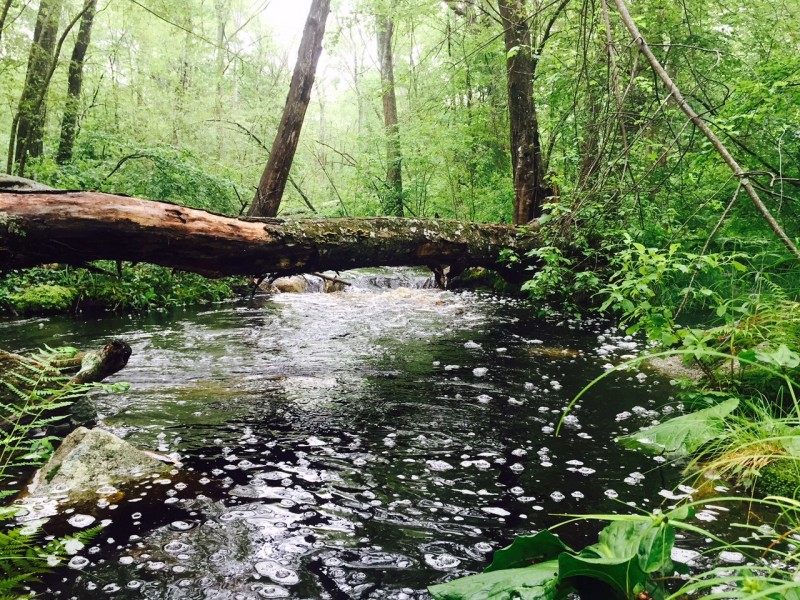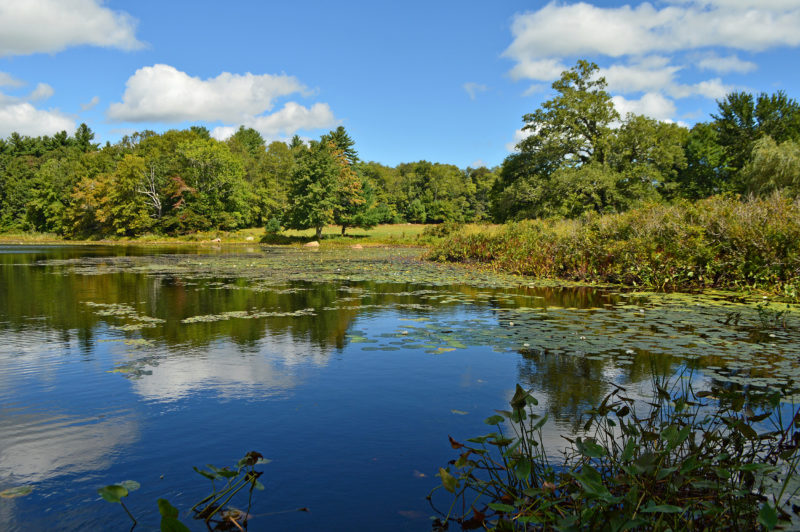Why can we save Buzzards Bay for future generations? Thank the forests
Compared to other estuaries along the East Coast – like Narragansett Bay, Long Island Sound, and the Chesapeake Bay – Buzzards Bay has one important difference: large areas of dense, healthy forests covering the land surrounding our water.
Forests are one of the key secrets behind the Bay’s relatively good health. To protect clean water for future generations, we need to protect these forests – because once they’re gone, we can’t get them back.
Why are forests important to clean water?

Forested buffers along streams like Angeline Brook in Westport work hard to protect clean water. They also help keep the stream cool, which is critical for sensitive fish like native sea-run brook trout.
Forests are an essential part of the Buzzards Bay ecosystem. You can’t have clean water and thriving fish and wildlife populations without healthy forests. These natural filters provide the biggest benefits to the Bay, including:
- Capturing rainfall and filtering out harmful nitrogen pollution.
- Holding soil in place, which prevents erosion.
- Keeping our air clean and cool.
- Shading coldwater streams where native brook trout live.
- Providing habitat for wildlife.
- Giving people a place to connect with nature.
As development has increased, it’s become more important than ever to protect forests. Poorly planned sprawling development means fewer forests and more paved roads, parking lots, and manicured lawns – all of which can harm the Bay’s health.
How much forest cover does the Buzzards Bay region have?
Every four years as part of the Coalition’s State of Buzzards Bay report, the Woods Hole Research Center looks at available land use data and satellite imagery. Scientists use this data to determine the percentage of forest coverage remaining in the Buzzards Bay watershed: the area of land where water flows from local rivers, streams, and groundwater into the Bay. According to the most recent analysis in 2015, 77% of our watershed is covered with forests.
When you compare that percentage to other East Coast estuaries, you can see why Buzzards Bay comes out ahead. In the Chesapeake Bay, only 57% of the watershed is forested. And the nearby Narragansett Bay watershed has less than 40% forest cover.
But that 77% figure isn’t as safe as it may sound. A full half of the watershed’s land area is unprotected from development. Just 27% is permanently protected. Many of these protected forests are places you know and love, like the Southeastern Massachusetts Bioreserve, Myles Standish State Forest, and the Mattapoisett River Reserve.
We can and must preserve the Bay’s most important remaining unprotected forests. If we don’t, we could see our beloved Bay go the way of those other East Coast estuaries, where clean water is just a memory.
How does the Coalition protect Buzzards Bay’s forests?

The forests and wetlands along the Mattapoisett River filter clean public drinking water for residents of Fairhaven, Mattapoisett, Marion, and Rochester. They also protect the river’s health.
The Coalition manages the largest land conservation program in southeastern Massachusetts. Since 1998, we’ve forever protected more than 8,000 acres of land across the region – a combined area larger than the size of the town of Fairhaven.
We’re constantly working to increase the amount of land we protect every year. And we’ve set our sights on a goal to protect another 27,000 acres of land around Buzzards Bay in the next 30 years.
We need to protect the Bay’s most important forests – and we need to do it within the next generation, as pressure to develop those unprotected forests will continue to creep into our region from the Boston and Providence metro areas. Unless we boost the pace of conservation, the Bay’s clean water, coastal habitats, and scenic beauty may not survive for our children and grandchildren.